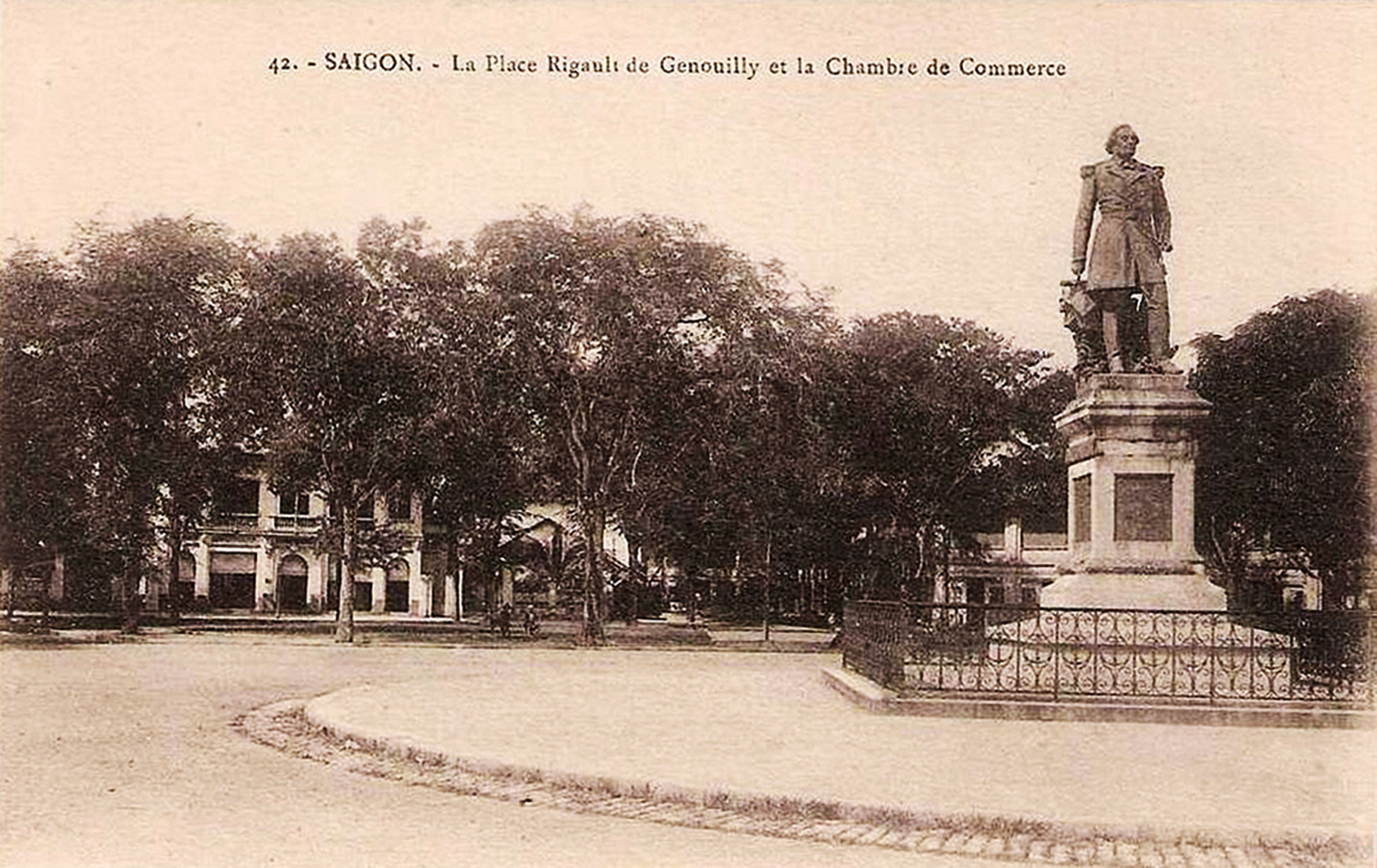
Saigon – Place Rigault de Genouilly and the Chamber of Commerce
This article was published previously in Saigoneer
The square known today as quảng trường Mê Linh has been home to five different monuments since its inception in the 1860s.
When it was first laid out in 1863 at the junction of rue Impériale (Hai Bà Trưng) and quai Napoléon (Tôn Đức Thắng), the square known today as Mê Linh square was designated the “Rond-point.” From the outset, it was seen to mark the southernmost point of the French Naval Port, which occupied a large area of land between the square and the shipyard.
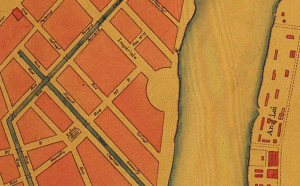
The Rond-point marked on an 1865 map of Saigon
In 1866-1867, three other roads – rue Vannier (Ngô Đức Kế), rue Turc (Hồ Huấn Nghiệp) and rue de Thu-Dau-Mot (Thi Sách) were laid out to intersect the square. The rue de Yokohama (Phan Văn Đạt) followed soon after, completing the modern road layout.
In 1868, Charles Lemire (Annales des voyages, de la géographie, de l’histoire et de l’archéologie, 1869) described the Rond-point unflatteringly as “a big empty space which is currently being transformed into a roundabout, or perhaps a square, where some benches have been placed in anticipation.”
At the time of Lemire’s visit to Saigon, residents of the square included: the first Chambre de commerce and briefly also the Municipal Council, which shared a compound at No 11; and the Cercle des Officiers, which occupied a temporary building at No 8 until the completion of its permanent home in 1876. The Hôtel de l’Univers, which opened in 1872 as a two-storey building on rue Vannier, was subsequently extended to overlook the square, with entrances on both rue Vannier and rue Turc.
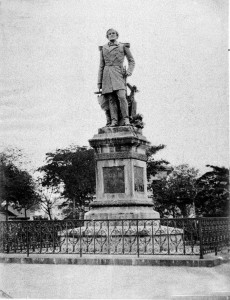
A close up of Alexandre Lequien’s statue of Admiral Rigault de Genouilly in the early 20th century
The first monument was set up on the square in 1875. Writing 13 years later, Louise Bourbonnaud (Les Indes et l’Extrême Orient, impressions de voyage d’une parisienne, 1892) described this monument as “a high pyramid in memory of Monsieur Navaillé, a prominent citizen who did much for the development of trade in Saigon and the colony.” She added that the cost of the monument was met by subscription.
A second, larger monument was added in 1878, when a statue of Admiral Charles Rigault de Genouilly (1807-1873), created by sculptor Alexandre Victor Lequien (1822-1905), was erected in the centre of the square, again paid for by public subscription. Admiral Rigault de Genouilly had led the joint French and Spanish force during the opening phase of the Cochinchina campaign (1858-1861), and also became Cochinchina’s first Admiral-Governor.
In his 1911 memoirs, Ma chère Cochinchine, trente années d’impressions et de souvenirs, février 1881-1910, lawyer George Dürrwell described the unveiling of the statue as follows:
“The inauguration of the Rigault de Genouilly statue was the object of a great patriotic gathering to which the entire population of Saigon was invited. This was an occasion which lacked nothing in solemnity: the highest authorities of the colony praised the hero of the day in the most generous terms; land and sea troops marched in parade in front of him; a poet celebrated the Admiral in pompous Alexandrine verse; and the youth of local schools performed a cantata featuring the chorus: ‘Come, children of Annamite France, To the land of steam and electricity!’ And in those few happy words were summarised the whole of our future programme.”

The monument to Ernest Doudart de Lagrée, pictured in the early 20th century
Henceforth, the Rond-Point became known as the place Rigault-de-Genouilly, and the wharf opposite was christened the appontement Rigault-de-Genouilly or Rigault-de-Genouilly wharf.
At some point in the early 1890s, the Navaillé monument was removed, and in 1893 it was replaced by another pyramid-shaped memorial, this one dedicated to the memory of Ernest Doudart de Lagrée (1823-1868), leader of the French Mekong Expedition of 1866-1868. The adjacent rue de Yokohama was then renamed rue Doudart de Lagrée.
In the late 1880s, a large building was constructed on the south corner of the square adjoining the quayside to house the Commissariat de Police for the 1st Arrondissement (District 1). That building survived until the 1990s, when it was demolished to build the Renaissance Riverside Hotel.
The place Rigault-de-Genouilly also became an important transport hub in 1891, when the terminus of the CFTI “Tramway de la route basse” (Low road tramway) steam tramway from Saigon to Chợ Lớn was installed on the quayside, right opposite the square. Four years later, this tramway line was extended eastward from the square and then northward through the city to Gò Vấp and Hóc Môn, transforming the place Rigault-de-Genouilly into a through-station.
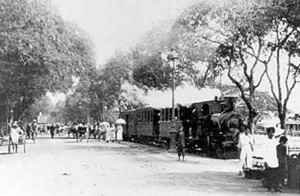
The quayside opposite the square became the terminus of the CFTI “Low Road” steam tramway from Saigon to Chợ Lớn in 1891
With the advent of new electric trams in 1923, lines were rerouted through the city centre, but in the twilight years of the French colony, between 1948 and the closure of the tramway network in 1954, congestion in the city centre led once more to trams running along the quayside, through the square and up rue Paul Blanchy [Hai Bà Trưng street].
One of the square’s best-known later landmarks was the factory of Brasseries et glacières de l’Indochine (BGI) at 6 rue Paul Blanchy. This company was set up by Étienne Denis and Louis Palanque in 1927, after they had taken over Victor Larue’s Larue Frères Industriels-Glacières-Brasseries. The factory building, designed by Paul Veysseyre, survived until November 2015, when it was demolished to make way for a new tower block.
Following the departure of the French in 1955, the Rigault de Genouilly statue was removed. In the same year, the Republic of Việt Nam government renamed rue Paul Blanchy (the former rue Impériale) as Hai Bà Trưng (“Two Trưng Sisters”) street, in honour of siblings Trưng Trắc and Trưng Nhị who rebelled against Chinese rule in the 1st century CE, while the place Rigault-de-Genouilly itself was renamed Mê Linh square, after the sisters’ home prefecture. Nearby rue Cornulier-Lucinière (the former rue de Thu-Dau-Mot) was also renamed Thi Sách street, after Trưng Trắc’s husband General Thi Sách, whose murder by the Chinese drove the two sisters to revolt.
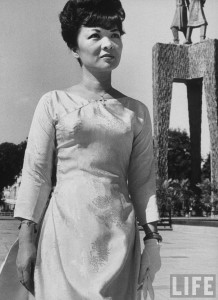
Madame Nhu posing in front of sculptor Nguyễn Văn Thế’s statue of the Trưng sisters (LIFE magazine image)
In March 1962, a lake was added and a statue of the Trưng sisters was ceremoniously installed at its centre. Created by sculptor Nguyễn Văn Thế, the statue depicted the two sisters on a large pedestal with three legs, each leg resembling the head of an elephant, the animal on which they are said to have ridden into battle.
However, the statue had been commissioned by the unpopular Madame Nhu, wife of President Ngô Đình Diệm’s brother Ngô Đình Nhu and at that time (the president being unmarried) de facto “First Lady.” It was rumoured that Madame Nhu had insisted that the sculptor use her own facial features as the model for the faces of the two sisters, and consequently, after the overthrow and assassination of Diệm and Nhu in November 1963, jubilant anti-government rioters tore down the statue.
It was replaced in 1967 by the current statue of Trần Hưng Đạo, a national hero who inflicted three successive defeats on Mongol invaders in the late 13th century. In addition to being a great military leader, Trần Hưng Đạo also authored an important literary work known as Hịch tướng sĩ (“Officers’ Proclamation”) and two famous military treatises, Binh thư yếu lược (“Book of Military Tactics”) and Vạn kiếp tông bí truyền thư (“Vạn kiếp Esoteric Book”).
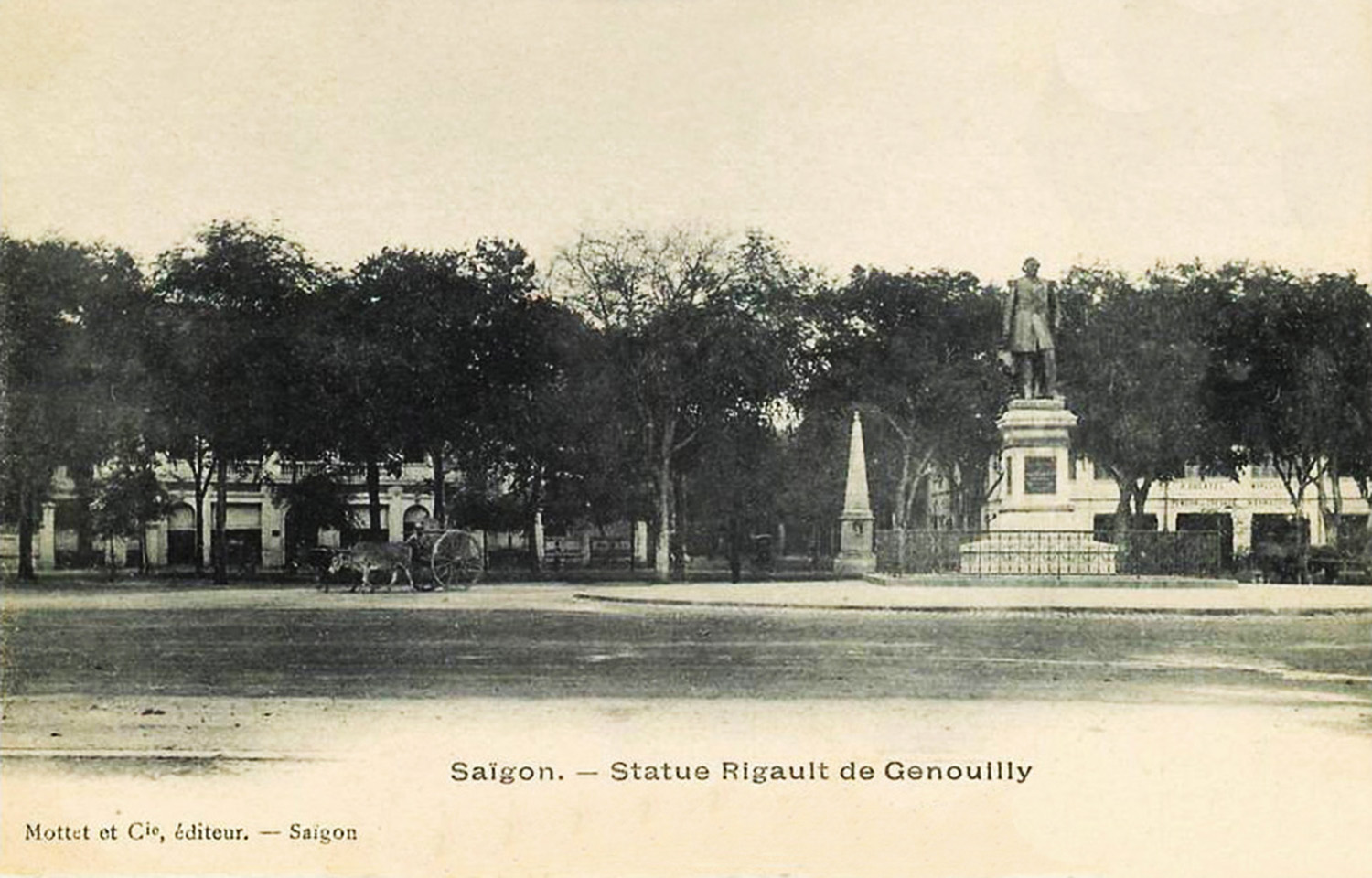
Saigon – Statue of Admiral Rigault de Genouilly

Charles Rigault de Genouilly (1807-1873) by Photo Cremière
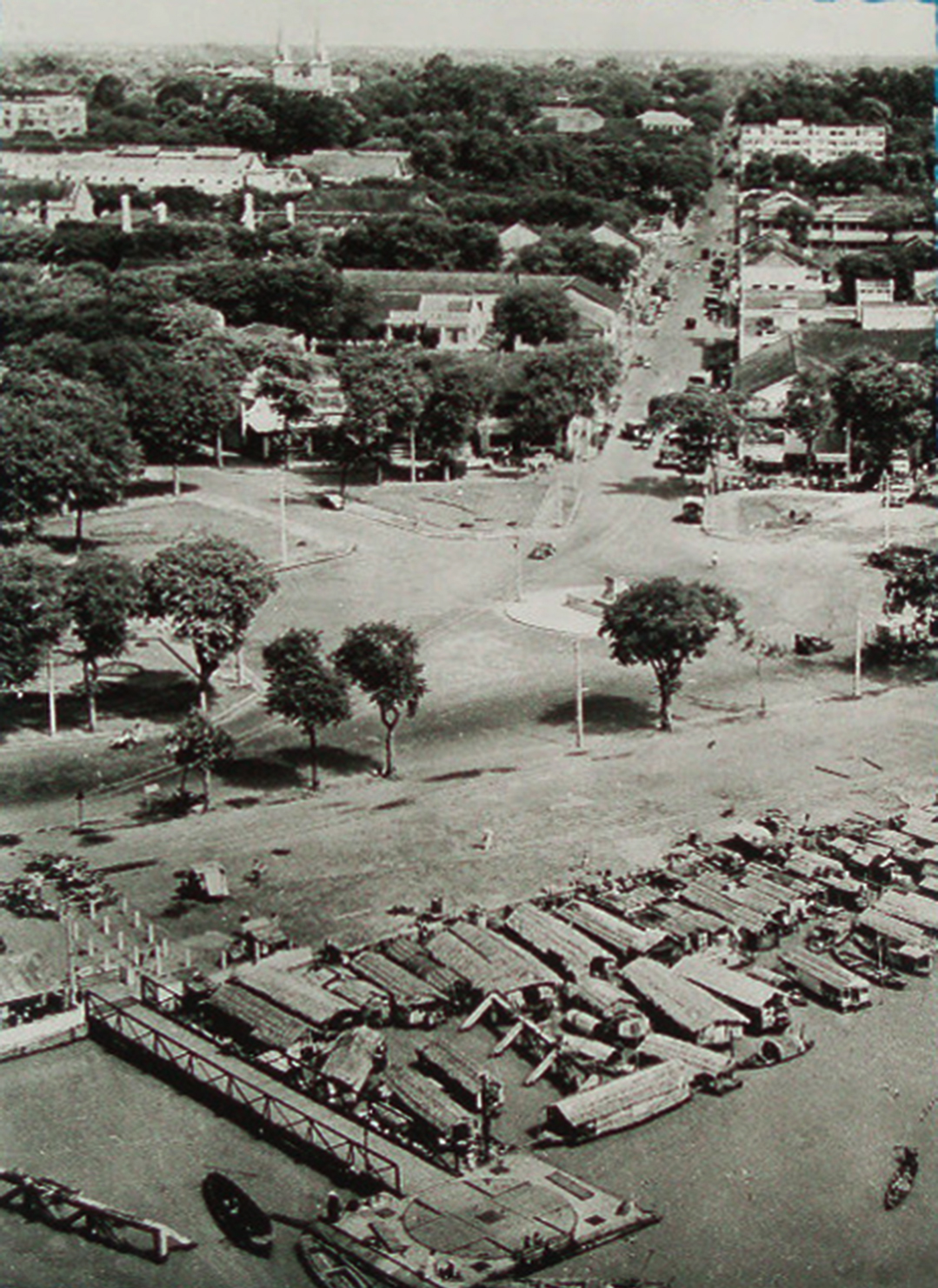
Electric tramway tracks may be seen in this mid 1950s image of Mê Linh Square
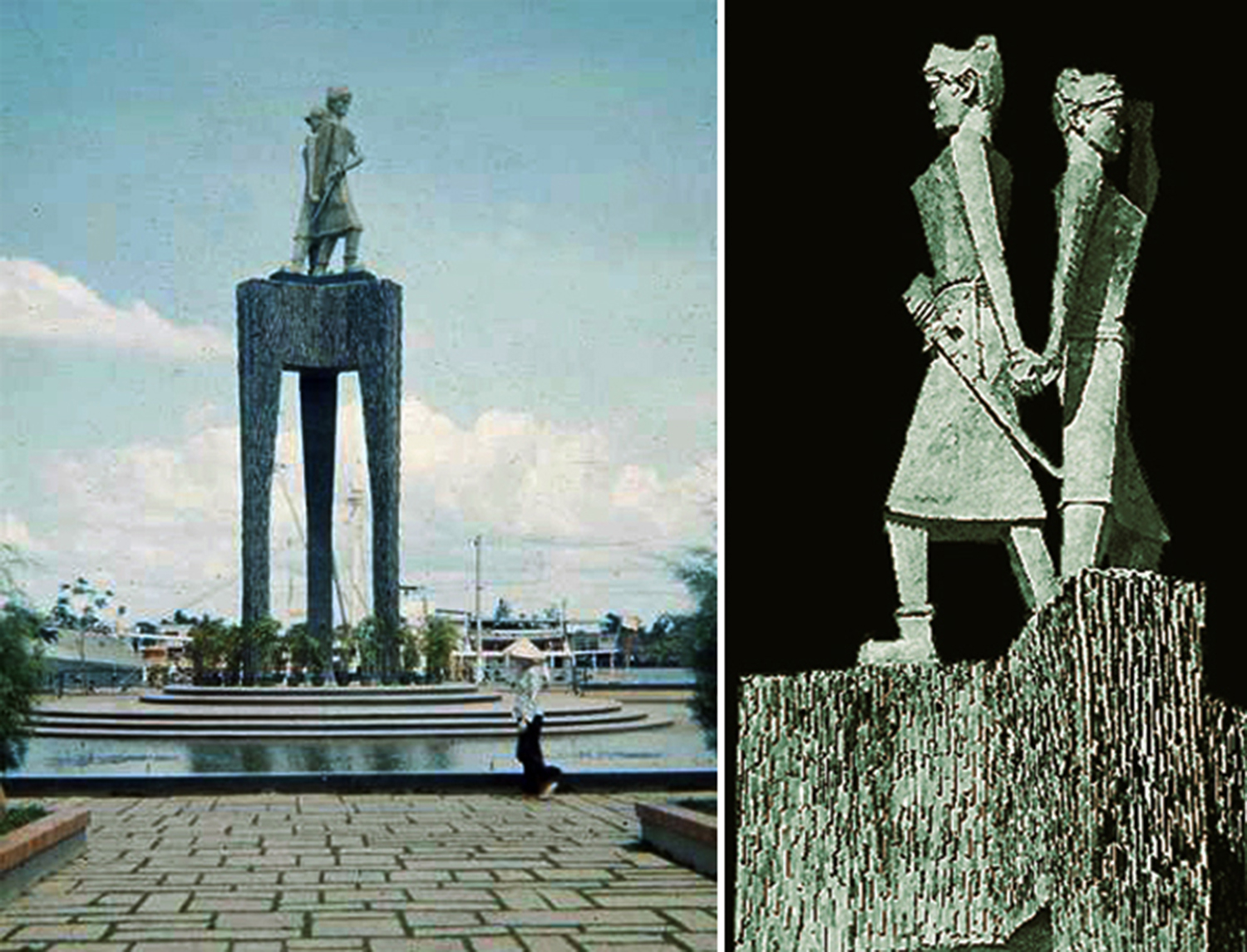
The 1962 Trưng sisters statue by sculptor Nguyễn Văn Thế
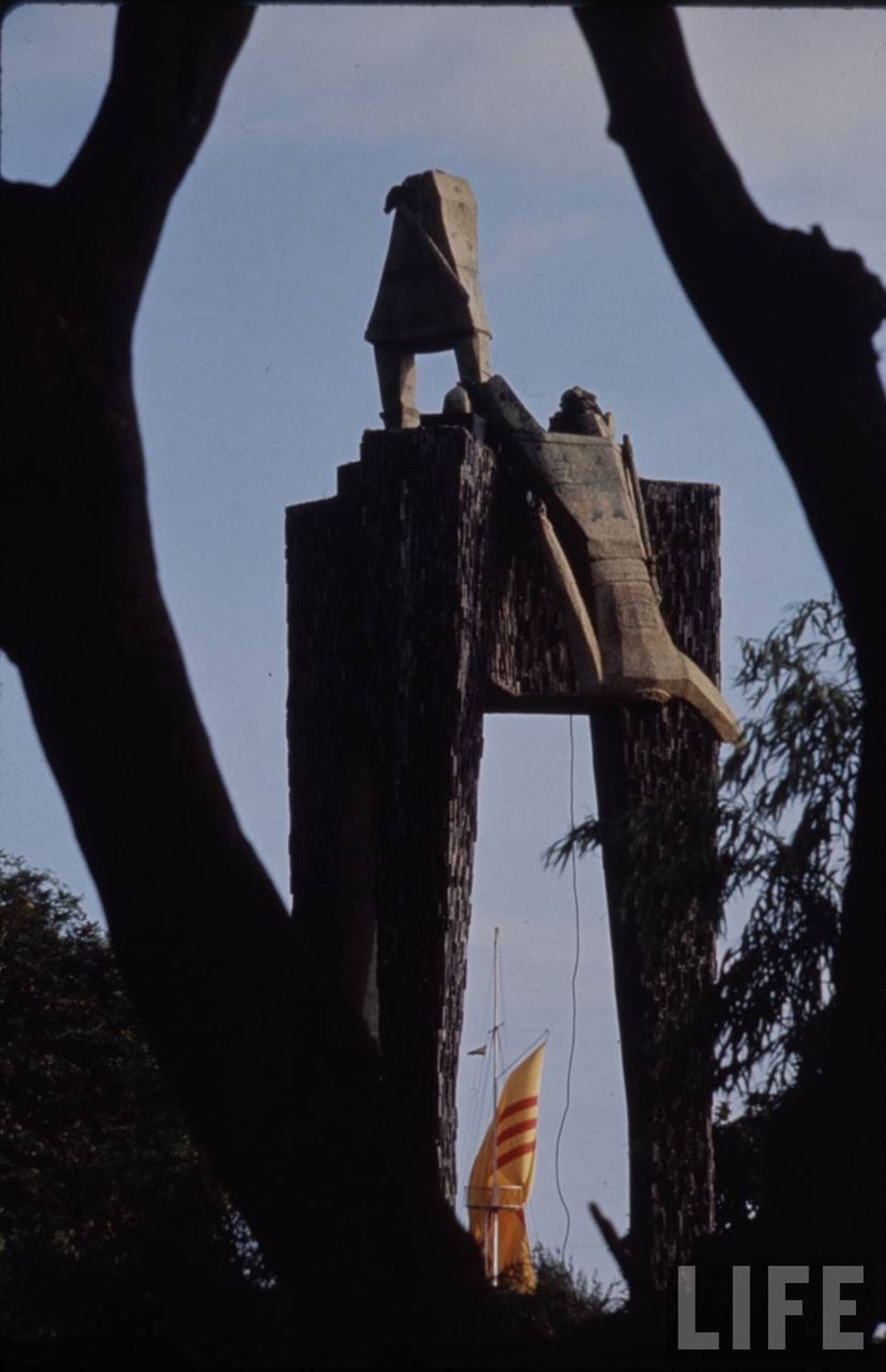
The Trưng sisters statue was destroyed in the wake of the November 1963 coup which overthrew President Ngô Đình Diệm (LIFE magazine image)
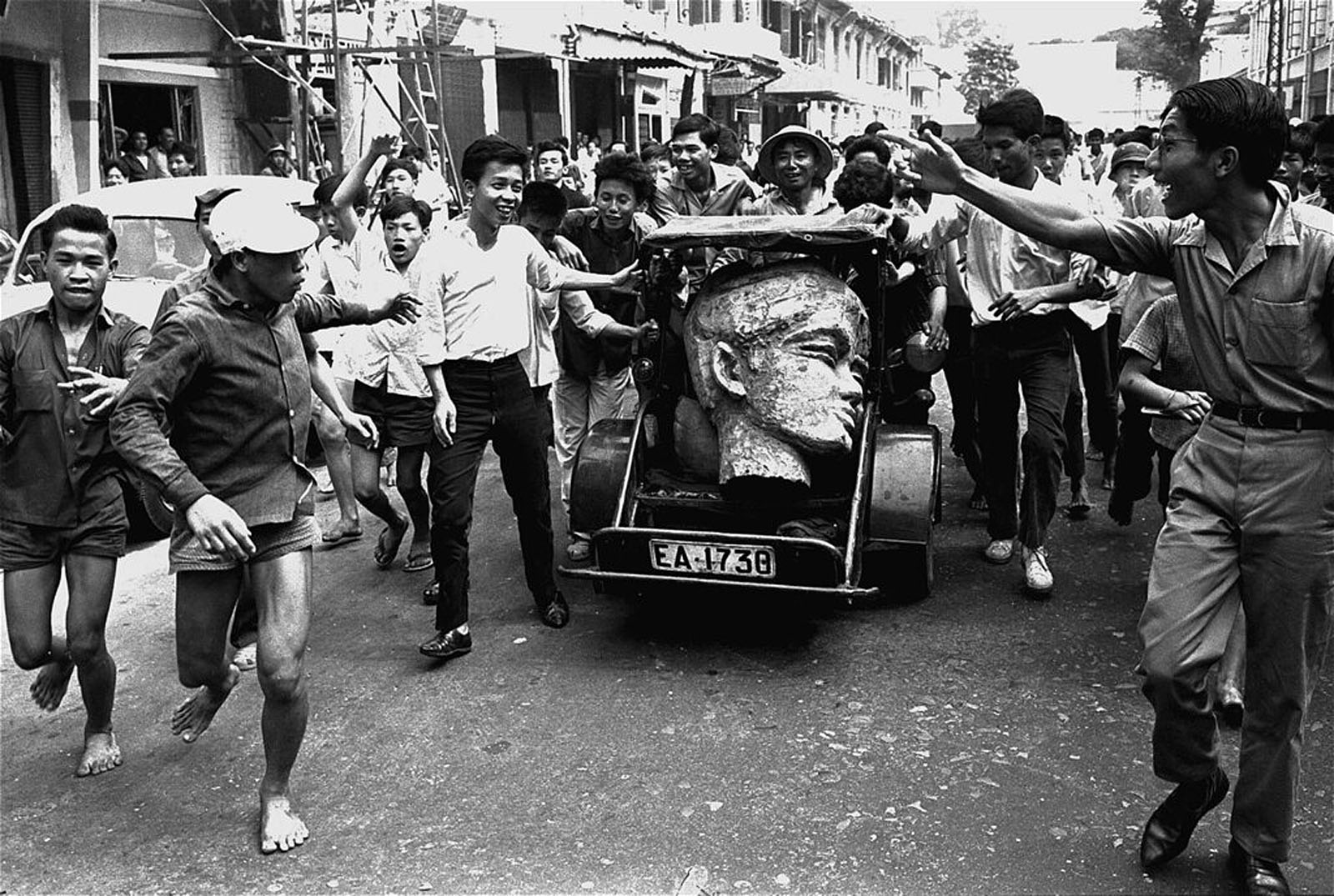
Saigon, 2 November 1963 – A Vietnamese crowd jeers as a peddicab driver carts the head of a demolished statue through the streets of Saigon, November 2, 1963, following the overthrow of the Diem regime. The monument was demolished by the crowd because of its resemblance to Mrs Ngô Đình Nhu, South Vietnam’s former first lady (AP Photo)
Tim Doling is the author of the guidebook Exploring Saigon-Chợ Lớn – Vanishing heritage of Hồ Chí Minh City (Nhà Xuất Bản Thế Giới, Hà Nội, 2019)
A full index of all Tim’s blog articles since November 2013 is now available here.
Join the Facebook group pages Saigon-Chợ Lớn Then & Now to see historic photographs juxtaposed with new ones taken in the same locations, and Đài Quan sát Di sản Sài Gòn – Saigon Heritage Observatory for up-to-date information on conservation issues in Saigon and Chợ Lớn.

